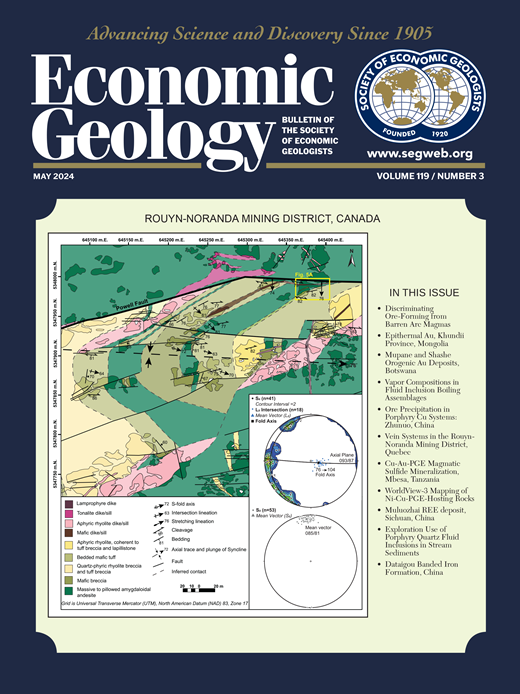小家营子莫夕卡岩矿床的高精度年代学:对长时间和幕式热液脉冲的启示
IF 5.5
1区 地球科学
Q1 GEOCHEMISTRY & GEOPHYSICS
引用次数: 1
摘要
矽卡岩系统中成矿过程的时间尺度和持续时间没有得到很好的约束。为了更好地理解这一点,我们对中国东北小家营子钼矽卡岩矿床(0.13 Mt Mo, 0.22 wt %)进行了高精度化学磨损-同位素稀释-热电离质谱(CA-ID-TIMS) U-Pb锆石和同位素稀释-负热电离质谱(ID-N-TIMS) Re-Os辉钼矿年代学研究。小家营子矿床与一个由辉长闪长岩、二黄长岩和花岗斑岩组成的侵入杂岩有关。在小家营子(0.11 Mt Mo)和康章子(0.02 Mt Mo)两个矿块中均有辉钼矿成矿。在康樟子矿块,钼矿化主要集中在与深部花岗斑岩相邻的矽卡岩中,花岗斑岩内部有少量浸染状和石英脉状矿化。小家营子矿块经济钼矿化主要集中在陡倾二黄长岩与中元古代雾雾山组接触部位之间的矽卡岩中,少量钼矿化存在于二黄长岩中赋存的石英和内矽卡岩脉中。两个矿块的夕卡岩矿化向下汇聚到矿化的花岗岩斑岩中。康章子矿块矽卡岩由近端深红棕色石榴石到远端浅部深绿色辉石划分。在小家营子矿块中,近端矽卡岩富含石榴石,而远离二黄道长—雾雾山组接触面则有辉石增生。辉石与侵入体的距离越远,Fe、Mn的富集程度越高;Pb、Zn、Ag向体系顶部增加;Mo和Fe随深度增加而增加。高精度CA-ID-TIMS U-Pb锆石年代学表明,辉长闪长岩结晶时间为165.359±0.028/0.052/0.18 Ma(不确定度为分析/+示踪/+衰变常数不确定度),二辉长岩和花岗岩斑岩结晶时间分别为165.361±0.040/0.059/0.19和165.099±0.026/0.051/0.18 Ma。高精度ID-N-TIMS Re-Os辉钼矿年代学表明,小家应子辉钼矿成矿发生在至少3个岩浆-热液脉冲(名义上在165.48±0.09 - 165.03±0.13、163.73±0.09和163.11±0.11 Ma之间)。辉钼矿首次成矿形成于外矽卡岩、内矽卡岩和石英脉中,最小持续时间为450±40 k.y,介于165.48±0.09/0.68/0.85 ~ 165.03±0.13/0.67/0.85 Ma之间。矽卡岩矿很可能代表了一系列矿化事件的复合,而不是在这些高精度数据的分析不确定性范围内能够识别的三个事件。最后,对切割二黄长岩和花岗斑岩的石英钼脉进行Re-Os测年,结果表明,部分成矿作用晚于观察到的侵入岩,在163.73±0.09/0.70/0.86 ~ 163.11±0.11/0.70/0.86 Ma之间,解释为深部未观察到的侵入岩的结果。总的来说,这些年龄表明,小家营子矿床的钼成矿作用持续时间至少为2.4 m.y。这些数据表明,个别岩浆和/或夕卡岩石榴石年龄可能严重低估了成矿作用的全部持续时间。此外,本研究强调,系统识别与多期侵入系统相关的矽卡岩矿床可能为未来的勘探提供目标,因为它可能指向以前未发现的矿产资源。本文章由计算机程序翻译,如有差异,请以英文原文为准。
High-Precision Geochronology of the Xiaojiayingzi Mo Skarn Deposit: Implications for Prolonged and Episodic Hydrothermal Pulses
The timescales and duration of ore-forming processes in skarn systems are not well constrained. To better understand this, we present high-precision chemical abrasion-isotope dilution-thermal ionization mass spectrometry (CA-ID-TIMS) U-Pb zircon and isotope dilution-negative-thermal ionization mass spectrometry (ID-N-TIMS) Re-Os molybdenite geochronology of the Xiaojiayingzi Mo skarn deposit (0.13 Mt Mo at 0.22 wt %), northeastern China. The Xiaojiayingzi deposit is related to an intrusive complex composed of gabbroic diorite, monzodiorite, and granite porphyry. Molybdenite mineralization occurred in two ore blocks, Xiaojiayingzi (0.11 Mt Mo) and Kangzhangzi (0.02 Mt Mo). In the Kangzhangzi ore block, Mo mineralization is concentrated in skarn adjacent to a deep-seated granite porphyry, with minor disseminated and quartz veinlet mineralization within the granite porphyry. In contrast, economic Mo mineralization in the Xiaojiayingzi ore block is concentrated in skarns located between the contact of steeply dipping monzodiorite and the Mesoproterozoic Wumishan Formation, with minor Mo mineralization found in quartz and endoskarn veins hosted in the monzodiorite. Skarn mineralization in both ore blocks converges downward into the mineralized granite porphyry. In the Kangzhangzi ore block, skarn is zoned from deep proximal dark red-brown garnet to shallow distal dark-green pyroxene. In the Xiaojiayingzi ore block, proximal skarn is garnet rich, whereas pyroxene increases away from the monzodiorite-Wumishan Formation contact. In addition, pyroxene becomes more Fe and Mn rich with distance from the intrusions; Pb, Zn, and Ag increase toward the top of the system; and Mo and Fe increase with depth.
High-precision CA-ID-TIMS U-Pb zircon geochronology indicates the gabbroic diorite crystallized at 165.359 ± 0.028/0.052/0.18 Ma (uncertainties presented as analytical/+ tracer/+ decay constant uncertainties), with subsequent crystallization of the monzodiorite and granite porphyry at 165.361 ± 0.040/0.059/0.19 and 165.099 ± 0.026/0.051/0.18 Ma, respectively. High-precision ID-N-TIMS Re-Os molybdenite geochronology indicates molybdenite mineralization at Xiaojiayingzi occurred in at least three discrete magmatic-hydrothermal pulses (nominally between 165.48 ± 0.09–165.03 ± 0.13, 163.73 ± 0.09, and 163.11 ± 0.11 Ma). The first episode of molybdenite mineralization formed in exoskarns, endoskarns, and quartz veins and had a minimum duration of 450 ± 40 k.y., between 165.48 ± 0.09/0.68/0.85 and 165.03 ± 0.13/0.67/0.85 Ma. It is likely that skarn ore represents a composite series of mineralization events, more than the three events capable of identification within analytical uncertainty of these high-precision data. Finally, Re-Os dating of quartz Mo veins cutting the monzodiorite and granite porphyry indicates that some mineralization postdated the observed intrusions, between 163.73 ± 0.09/0.70/0.86 and 163.11 ± 0.11/0.70/0.86 Ma, interpreted to be the result of deeper, unobserved intrusions. Collectively, these ages indicate that protracted, pulsed Mo mineralization at the Xiaojiayingzi deposit occurred over a period of at least 2.4 m.y. These data suggest that individual magmatic and/ or skarn garnet ages may significantly underestimate the full duration of mineralization. In addition, this study highlights that systematically identifying skarn deposits associated with multiphase intrusive systems may reveal targets for future exploration, as it may point to previously undiscovered mineral resources.
求助全文
通过发布文献求助,成功后即可免费获取论文全文。
去求助
来源期刊

Economic Geology
地学-地球化学与地球物理
CiteScore
10.00
自引率
6.90%
发文量
120
审稿时长
6 months
期刊介绍:
The journal, now published semi-quarterly, was first published in 1905 by the Economic Geology Publishing Company (PUBCO), a not-for-profit company established for the purpose of publishing a periodical devoted to economic geology. On the founding of SEG in 1920, a cooperative arrangement between PUBCO and SEG made the journal the official organ of the Society, and PUBCO agreed to carry the Society''s name on the front cover under the heading "Bulletin of the Society of Economic Geologists". PUBCO and SEG continued to operate as cooperating but separate entities until 2001, when the Board of Directors of PUBCO and the Council of SEG, by unanimous consent, approved a formal agreement of merger. The former activities of the PUBCO Board of Directors are now carried out by a Publications Board, a new self-governing unit within SEG.
 求助内容:
求助内容: 应助结果提醒方式:
应助结果提醒方式:


